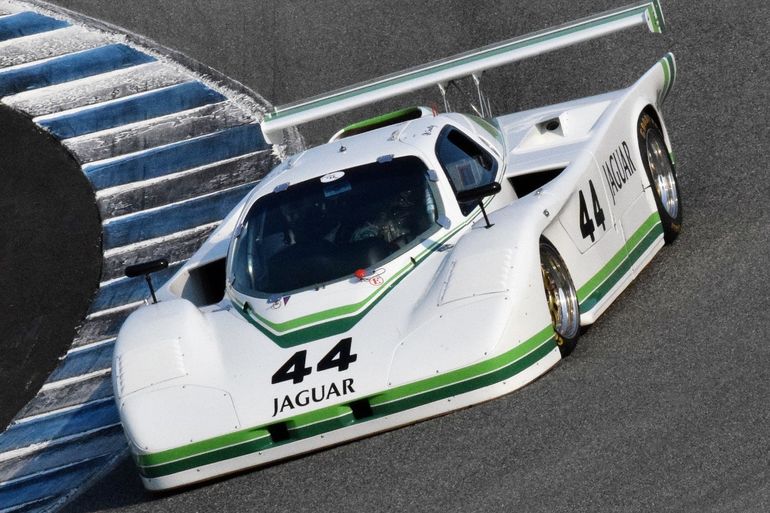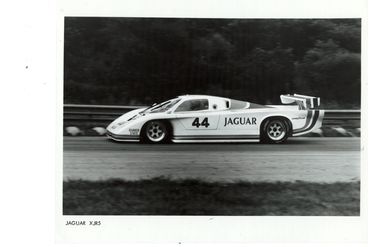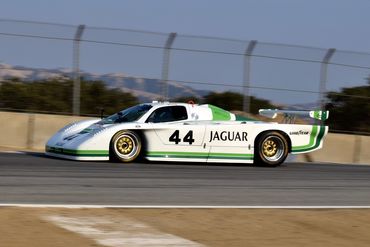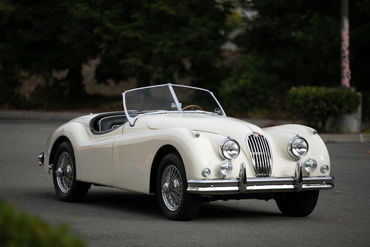Sold
SOLD 06/20
1985 Jaguar
XJR-5
The Final and Most Technically Sophisticated of the Legendary Group 44 Race Cars. Ready to Race or Show Anywhere. Recent Winner at the Monterey Historic Reunion and Quail Motorsports Gathering. A Historical Icon and Welcome Entrant to Prestigious Historic Racing Events Including Le Mans Classic.
- VIN010
- Exterior ColorWhite and Green with #44 period racing livery
- Interior ColorBlack
- MileageTMU
- Engine6.0 Liter V12
- TransmissionHewland 5-Speed Transaxle
- StatusSold
- StockFJ2394
Description
1984 Jaguar XJR-5 Group 44
s/n 010
White and Green with #44 period racing livery
Bob Tullius might have wound up simply as a footnote in any of the local East Coast racing newsletters, if it weren’t for the fact that his budding racing career was impacting his performance as a salesman for Kodak. After his boss realized Tullius had been missing too much work due to his racing hobby, Tullius was given an ultimatum; his job or his racing hobby. And while many of us might have chosen the safer route, Tullius wisely chose to go racing. By 1963 he was racing full time, becoming the principle driver for Triumph North America, participating in 12 Hours of Sebring, and winning no less than six SCCA championship races in a factory TR4. In 1965 Tullius established his own racing team, Group 44. Certainly, a lean operation at inception, Group 44 began to grow, attracting customers and media attention in part due to their business approach; race their own cars, build cars for paying customers, and offer an extensive marketing and sponsorship department for vehicle manufacturers and racing teams. Among their many marketing and promotional tools, Group 44 went everywhere in ubiquitous green and white transport vehicles, appearing at multiple racing events. With their advertising and market savvy and immaculately presented vehicles, and winning race after race, Group 44 was a small company making a big name.
Over the course of their twenty-five years of racing and building, Group 44 was exclusively associated with British Leyland, managing nearly all of Leyland marketing in the US both for motorsport and production vehicles. This allowed them access to all manner of cars, a diverse range of racecars, and the resources to bring cutting edge ideas to modern racing. During their operating years, the Group 44 team achieved over 300 race victories including 14 National SCCA championships, 3 Trans Am titles, and 11 IMSA GTP championship races, including the participation of this particular car, chassis number 10, in the IMSA series.
Beginning in 1981, Group 44 and Jaguar engaged in discussions for plans to field a competitive ground effects prototype for IMSA Camel GTP. The cars would engage in wind tunnel testing, mechanical development headed by Lee Dykstra, with sponsorship from JRT and Quaker State Oil. Group 44 was tasked with a daunting set of requirements but quickly responded with the first car delivered by August 1982 as a Jaguar XJR-5 with a 3.5L V12 engine. GTP was a juggernaut of power and competition with multiple competitors in the field, funded by millions of dollars. Hotly contested by heavy hitters like Porsche, BMW, and Ford, each with prodigeous technical support, Group 44 was substantially outgunned. But Tullius and his teams consistently proved out with wins at Road Atlanta, Lime Rock, Mosport, and Pocono, further refining their cars along the way. Eventually the team would prepare two cars intent on recapturing the former magic Jaguar had achieved with multiple wins at Le Mans. Two cars were prepared and entered for the 1984 24 Hours of Le Mans. Though drivers Tullius, Redman and Bundy (as well as others) placed well at 14th and 19th against the powerful Porsche 956s, the actual race produced disappointment with an incident damaging one car and a broken gearbox ending the journey for the other. Returning again in 1985 proved fruitful with the Robinson, Tullius, Ballot-Lena #44 car (chassis #008) clinching the win in the GTP class and posting a victory for Jaguar at Le Mans.
Over the course of their three-year development, Group 44 built ten cars for various racing duties, the last few of which were redesigned to allow the engine to no longer assume structural duties as a stressed chassis member. Though originally a clever method for weight reduction and underbody aerodynamic advantages, the Lee Dykstra developed chassis was later modified due to problems with the initial design of the earlier stressed member engine and chassis layout. Although the cars performed quite well and offered important advances for Jaguar, it was clear that Group 44 was no longer able to retain their position. Halfway through the 1985 season the writing was on the wall for Group 44 as Jaguar shifted their motorsport interest to Tom Walkinshaw Racing to develop the XJR-6 for the World Sportscar Championship.
According to the Group 44 press release accompanying the car, the XJR-5 ground effects prototypes were specifically constructed for endurance racing. The molded Kevlar body sections, reinforced with Nomex honeycomb substructure, draped over a steel and aluminum semi-monocoque chassis of unique construction, allowing a lightweight car with superb chassis dynamics. With a dry weight of just over 1900lbs and 525 hp the V12 engine was capable of powering the car to speeds in excess of 220 mph and up to 240 mph depending on gearing and track conditions. With 1982 and much of 1983 considered development years, the later series cars benefited tremendously from lessons learned on the track, resulting in highly refined cars by the time the last of the few prototypes that were completed.
This particular example is the 10th Jaguar XJR-5 built and is specifically noted to be the last of the cars built in this series (#011 having been developed only for display). According to Group 44 documents, #010 was the 1984 Le Mans T-Car and was used for press rides and shows during 1986 and 1987. Because of being the last built for competition, #010 thus carries all the notable technical improvements that ensued over the course of the three-year Group 44 IMSA GTP program with Jaguar. This chassis design is also the most desirable in that the engine is not a stressed member, as it was in the earlier iterations. It is also uniquely configured as a “sprint race chassis” using distinct construction methods that make it specifically refined for shorter distance courses. Chassis #010 competed in the following races in the 1984 and 1985 season, driven by Doc Bundy, Bob Tullius, and Chip Robinson:
2nd place – August 5, 1984 Sears Point Ford California GT
2nd place – September 9, 1984 Pocono Camel GT Grand Prix
11th place – September 16, 1984 Michigan 500km Camel GTP/GTO
4th place – March 23, 1985 12 Hours of Sebring Coca-Cola Classic
DNF (engine) – August 4, 1985 Sears Point Ford California GT
DNF (trans) – October 4, 1985 Columbus 500km Ford Dealers
In addition to the races, this car also participated in several events including appearances in multiple 1984 and 1985 season races such as Pocono, Miami Grand Prix, Watkins Glen, Daytona (test), and Sebring 12 Hours. The car remained with Group 44 until the early 1990s when it was sold to independent racecar enthusiasts.
Beginning in 2009, #010 underwent a comprehensive mechanical and cosmetic restoration by marque experts Jim Busby and Rick Knoop. During the restoration, which was completed around 2010, legendary engine builder Ed Pink built the V12 engine to precision specifications confirmed by dyno test results delivering power well in excess of 500hp. Every aspect of the car was professionally tended to with exacting standards throughout the process, resulting in a phenomenally well-prepared car. Upon completion, the car participated in the 2010 Rolex Monterey Motorsports Reunion, posting a blistering first position 1:25.7 lap time in practice. The car was then sold to the current owner in 2014, who engaged Williams Racing Developments to rebuild the Hewland gearbox including a VG512:31 ring and pinion, new gear set, and VG5 RSR input shaft. In 2015 a spare, new custom race crankshaft was supplied by Ed Pink with matching specifications to the EPRE engine (itself a $5,000 item with a one year wait list). In August of that same year, the car was invited to be exhibited at the prestigious Quale gathering in Carmel, CA, where it won first place in its class, “Long Tail Cars of Le Mans”, and has since continued to win other various shows when attended. Also, in 2015, and later in 2019, #010 was raced at the Daytona 24 Hour Classic. The engine has amassed approximately 20 hours since it was built by Ed Pink in 2010.
In 2017 all suspension corners were crack checked, two front and two rear uprights mag recoated and replaced, and new bearings, races, and seals installed. Throughout the course of the current five-year ownership, the car has been meticulously maintained and professionally serviced by racecar specialists particularly well-versed in GTP racecars. In 2019, the engine was compression tested showing results of 170-175 across all 12 cylinders. The current owner also commissioned the restoration of the bodywork as well as the construction of a new nose section with headlights for night driving events.
Today this amazing XJR-5 is not only the most refined and well-developed of all the XJR GTP cars, it is among the finest mechanically and cosmetically prepared car of its type. The spectacular restoration is exemplary in every respect from the correct Group 44 Jaguar period racing livery to the countless mechanical details that define the technical and design mastery of these astounding V12 powered race cars. #010 is finished with beautiful paint and graphic details of very high quality, featuring exceptional gloss, correct sponsorship markings, and excellent recently completed body and paint work, including a spare headlight trimmed nose in matching livery. The two-tone ‘green ribbon’ graphics are iconic visual signatures reminding everyone of the era when all Group 44 cars displayed this dynamic livery. The ultra-lightweight Randy Witeen Kevlar body skin with Nomex honeycomb reinforced body design is not only superb for aerodynamic efficiency, the cab-forward design, low profile, and long tail, deliver a powerful sense of speed even while standing still. The exterior features are beautifully detailed including the centrally suspended low profile rear wing, clear lenses, clear windscreen and side windows, mechanical fasteners, and the massively wide gold lace three-piece BBS wheels. The spectacular restoration is exemplary in every respect from the correct Group 44 Jaguar period racing livery to the countless mechanical details that define the technical and design mastery of these astounding V12 powered race cars. #010 is finished with beautiful paint and graphic details of very high quality, featuring exceptional gloss, correct sponsorship markings, and excellent recently completed body and paint work, including a spare headlight trimmed nose in matching livery. The two-tone ‘green ribbon’ graphics are iconic visual signatures reminding everyone of the era when all Group 44 cars displayed this dynamic livery. The ultra-lightweight Randy Witeen Kevlar body skin with Nomex honeycomb reinforced body design is not only superb for aerodynamic efficiency, the cab-forward design, low profile, and long tail, deliver a powerful sense of speed even while standing still. The exterior features are beautifully detailed including the centrally suspended low profile rear wing, clear lenses, clear windscreen and side windows, mechanical fasteners, and the massively wide gold lace three-piece BBS wheels.
The lightweight body panels are easily removed revealing a dizzying array of engineering excellence, heralding the most advanced technology of the times, supported by top level professionals that have more recently prepared the car. With the rear section removed, the engine, gearbox, and suspension are exposed for detailed examination, showing the care and attention afforded to authentic period details while also updating the car to meet competition requirements for current Historic Races and events. The narrow and long Jaguar V12 engine sits proudly at mid-position, echoing the very first mid-engine racing Jaguar XJ13, itself a car of mythic proportions. Every aspect of this car has been professionally addressed to the highest level of technical proficiency including the interior and safety systems, engine management systems, instrumentation, braking and suspension corners, all of which are ready for serious competition.
The car is accompanied by a voluminous amount of engine and suspension spares including a complete spare front body section, spare side windows, two spare sets of BBS wheels with Good Year Eagle racing tires (one of which is from the original competition period, and should be used solely for display), several boxes full of engine components including a brand new specialized Ed Pink Crankshaft, aluminum engine covers, pistons, rings, main caps, side rod bearings, valve springs, head gaskets, several cylinder heads, used crank cases, misc. bearings, cylinder sleeves, cam gear spacers, new cam shafts, gaskets and spare drive chains, narrow grooved main bearings, misc. gears, suspension components, suspension uprights, spare wheel hubs of various sizes and offsets, spare gear cluster and spare gears, spare brake rotors, various Lucas and RCV performance parts, and spare center wheel locks. Also included with the car are numerous historic documents from Group 44, copies of press releases, period photographs, reference materials and specifications on the Jaguar XJR program, Ed Pink dyno sheets, detailed specifications for the engine currently installed in the car, and receipts for work recently performed on the car.
Given the amazing history of Jaguar and their ongoing involvement in racing endeavors today, the period marking their return to Le Mans is among the most important and dramatic, given the IMSA GTP series and the advances in racing that occurred throughout this era. The remarkable vision of Tullius and his tenacity building the Group 44 brand and cars are embodied in every aspect of this remarkable final iteration of the Jaguar XJR-5, in effect Group 44s final and most dramatic contribution to racing. The stunning and powerful visual impression combined with the mechanical excellence of this exceptional car truly offers a unique opportunity for its next bold and capable motorsports enthusiast to participate in multiple historic racing events, shows, and compete handily at the front of the pack.
The above vehicle information is complete and accurate to the best of our knowledge at the time it is posted to this website. Corrections or additional information is always appreciated. All advertised prices exclude government fees and taxes, any finance charges, any dealer document preparation charge, and any emission testing charge. Vehicles are subject to prior sale. All advertised to be true but not guaranteed. We assume no liability for errors or omissions.
Inquire About This Car
Fantasy Junction • 510-653-7555 • 1145 Park Ave, Emeryville, CA 94608





